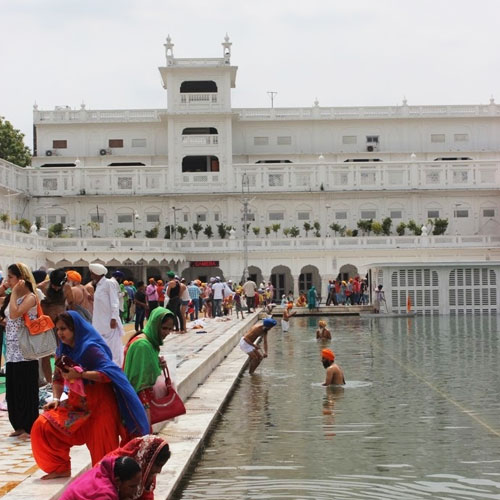

This is the first Sarovar in Sikh history. Situated near the Town Hall of the walled city and approximately 700 meters from Sri Harmandir Sahib, this spot marks the place where the fourth Sikh Guru, Sri Guru Ram Dasji, came from Sri Goindwal Sahib on the instruction of the third Guru, Sri Guru Amar Dasji to identify a spot for the excavation of the Sarovar. The legend has it that during the time that the Sarovar was being dug, Sri Guru Ram Dasji found a Yogi, (saint) meditating at the spot. After some time the Yogi opened his eyes and told Sri Guru Ram Dasji that he had been meditating there for a long time, waiting for a Guru to give him salvation. He disclosed his name as Santakha and then breathed his last. The tank was then named Santokhsar. The fifth Guru, Sri Guru Arjun Devji completed the unfinished work of the Sarovar - Santoksar. The work at this site was completed in 1643. In 1881, it was connected to a handle (water channel) bringing the water of the River Ravi to the Amritsar sarovars
The making of this Sarovar is associated with the sixth Sikh Guru, Sri Hargobind Sahibji. He is credited with introducing martial arts and weapons training to Sikhs. Following his father's martyrdom, he created a standing military force for the defense of the masses. He carried two swords “Miri" and "Piri”. Miri signified “Temporal Power” and Piri” signified "Spiritual Power", the first to smite the oppressor and the other to protect the innocent.
Though it is the smallest of the five samovars, this site marks the exact location of the formal beginning of the Sikh scripture making it a site of special significance for all Sikhs. Located near the Chhatwind Gate on the South Western side of the walled city of Amritsar, it is a small marble-lined hall topped by a gilded fluted lotus dome. The gurudwara was built in 1855 but the site has a much older history. Sri Guru Arjun Devji, the fifth Sikh Guru who was looking for a quiet spot away from the growing city of Amritsar. He chose this site as the spot where the Sri Guru Granth Sahib would take form. In 1602 to make the surroundings more agreeable, he had a small tank dug. Sri Guru Arjun Devji named it 'Ramsar' after his father Sri Guru Ram Dasji. Here, the Guru Sahib set about collecting the hymns of the first four Gurus, Sri Guru Nanak Devji
This is the Sarovar next to the Gurdwara Mata Kaulan near the main Darbar Sahib at Harmandir Sahib. It is named after a holy lady who was raised as a Muslim called Bibi Kaulan, the adopted (possibly Hindu) daughter of the Qazi of Lahore. She was a highly spiritual woman who was above religious divides and took refuge with the sixth master Sri Guru Hargobind Sahibji at Amritsar (1606- 1645). The samadhi of the lady, who is called Mata Kaulan lies at the western end of the Sri Kaulsar Gurdwara.
The excavation for the construction of the Sri Amrit Sarovar - Sri Harmandir Sahib began on 6th November 1573 and was completed in 1577. The original pond was turned into a masonry structure in 1584. The foundation of Amritsar was laid by Sri Guru Ram Dasji on the land purchased during the time of the third Sikh Guru, Sri Guru Amar Dasji. The tank is 500 feet in length, 490 feet in width, and 17 feet deep. It originally was filled only with rainwater and would dry up when rainfall was inadequate. During the British regime, in 1866, the Bhansali was connected with the Upper Bari Doab Canal and since then the water supply has been taken from there.